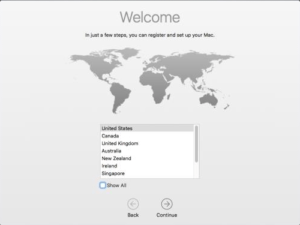Install El Capitan On New Ssd
First, launch Disk Utility on your Mac. Next, choose the SSD disk and go to the Erase tab. Set name and choose the format – OS X Extended (Journaled), and Partition map are entered by default. Go to the App Store and download OS X El Capitan installation. Launch “Install OS X El Capitan” and follow the steps the installation program prompts. The new OS X El Capitan features a new Split View, features in Safari, Mail, Notes, Maps, and Photos, and more. To get your hands on all this new stuff, you have to install the operating system on. Open the disk image, then open the.pkg installer inside the disk image. It installs an app named Install Version Name. Open that app from your Applications folder to begin installing the operating system. MacOS Sierra 10.12 can upgrade El Capitan, Yosemite, Mavericks, Mountain Lion, or Lion.
Install Mac Os X El Capitan On New Hard Drive To Windows 10 Oct 01, 2015 An alternative approach is to create a dedicated installation drive from the El Capitan installer, and use that to install the upgrade. Install El Capitan OK, now you can click that Continue button in the installer window. (If the installer isn’t running, go to your Applications folder and double click the Install OS X El Capitan. Depending on what version of Mac OS X is on the computer right now, you can try to use Recovery Mode (Command + R on boot) to reinstall. A better option may be to use a USB installer drive for El Capitan or whatever version you are hoping to reinstall.
My MacBook Air is running a 120GB SSD drive so I don’t want my hard drive full of excess things I don’t need. I just noticed after El Capitan that I lost a lot of space. I only had 10GB free. To run well a mac hard disk needs at least 20% free. Here’s how I freed up some more space.
I ran Disc Inventory X to see where the excess space was taken.
1. Remove old iPhoto library.
Look at this screenshot from Disk Inventory X: The pink section surrounded by the yellow line is my old ‘iphoto’ library. The large turquoise section to the left is the new ‘Photos’ library. El Capitan came with a new app called ‘Photos.’ The new Photos app imported my old iPhoto library, but it didn’t delete it! They are the same photos, the entire library has been duplicated. Deleting my old iPhoto library released almost 7 G of space!
To find the file just right click on the box and select ‘reveal in finder’:
This took me to the following folder:

Free online convert png to icokeyclever. I just dragged this to the trash and saved 6.6GB.
While I was at it I went to my ‘Applications’ folder and deleted the old ‘iphoto’ app which took up 1.7GB.
I could do this pretty confidently because my macbook air is my second machine, all my photo’s are only home computer if anything goes wrong.
2. Gmail ‘All Mail’
This huge multicoloured box turns out to be the Gmail ‘All Mail’
I discovered 15GB of gmail data in Apple Mail. Yes Apple mail now by default seems to download the gmail ‘All Mail’ folder which included every email you’ve ever deleted on gmail. The ‘All mail’ folder had over 17,000 emails in it. No wonder my internet usage was high last month – my laptop must have downloaded the entire 15GB of emails from gmail.
Install Os X El Capitan On New Hard Drive
Thankfully it was a simple fix.
Here’s how to disable the ‘All mail’ folder from being downloaded to your Macintosh.
Go into Gmail.com, then go to Settings on the top right menu, then under the ‘Labels’ tab I changed ‘All Mail’ to ‘Hide’
Install Mac Os X El Capitan On New Hard Drive
I still needed to delete the files from the hard disk manually.
I am using OSX El Capitan, and Mail version 9.1. I am not sure what other versions of mail have this problem.
Other items…
The were some other files I found with Disk Inventory X, (Old installers, old apps, some movies) and when I deleted them all in total I recovered 30GB!
Hi Blackcells:
I assume that you have gone into 'System Preferences' > 'Startup Disk' and set it to your original drive in data doubler.
Try removing your new SSD and putting it in an external caseOWC external case or using a USB to SATA adapter USB to SATA adapter and connect it to your MBP via USB.

Open Disk Utility>Erase and format the SSD to Mac OS Extended (Journaled) and a GUID partition.
Then use a third party application such as Carbon Copy Cloner Carbon Copy Cloner (Not free, but worth the price) or Super Duper to copy all data from the internal HDD as well as the recovery partition.
The clone will be a exact copy of your hard drive and it will be bootable.
Boot the MBP with the OPTION key and select the new SSD.
If it boots the MBP, perform the physical swap of drives.

Kim
Install El Capitan Dmg
Mar 9, 2016 4:07 AM